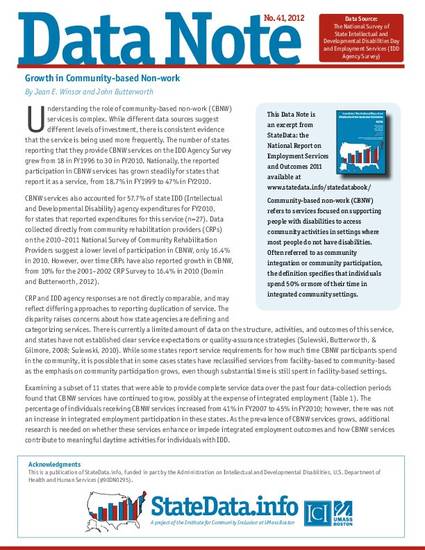
Understanding the role of community-based non-work (CBNW) services is complex. While different data sources suggest different levels of investment, there is consistent evidence that the service is being used more frequently. The number of states reporting that they provide CBNW services on the IDD Agency Survey grew from 18 in FY1996 to 30 in FY2010. Nationally, the reported participation in CBNW services has grown steadily for states that report it as a service, from 18.7% in FY1999 to 47% in FY2010.
CBNW services also accounted for 57.7% of state IDD (Intellectual and Developmental Disability) agency expenditures for FY2010, for states that reported expenditures for this service (n=27). Data collected directly from community rehabilitation providers (CRPs) on the 2010-2011 National Survey of Community Rehabilitation Providers suggest a lower level of participation in CBNW, only 16.4% in 2010. However, over time CRPs have also reported growth in CBNW, from 10% for the 2001-2002 CRP Survey to 16.4% in 2010 (Domin and Butterworth, 2012).
CRP and IDD agency responses are not directly comparable, and may reflect differing approaches to reporting duplication of service. The disparity raises concerns about how state agencies are defining and categorizing services. There is currently a limited amount of data on the structure, activities, and outcomes of this service, and states have not established clear service expectations or quality-assurance strategies (Sulewski, Butterworth, & Gilmore, 2008; Sulewski, 2010). While some states report service requirements for how much time CBNW participants spend in the community, it is possible that in some cases states have reclassified services from facility-based to community-based as the emphasis on community participation grows, even though substantial time is still spent in facility-based settings.
Examining a subset of 11 states that were able to provide complete service data over the past four data-collection periods found that CBNW services have continued to grow, possibly at the expense of integrated employment (Table 1). The percentage of individuals receiving CBNW services increased from 41% in FY2007 to 45% in FY2010; however, there was not an increase in integrated employment participation in these states. As the prevalence of CBNW services grows, additional research is needed on whether these services enhance or impede integrated employment outcomes and how CBNW services contribute to meaningful daytime activities for individuals with IDD.
Available at: http://works.bepress.com/john-butterworth/3/

Data Note No. 41. This is a publication of StateData.info, funded in part by the Administration on Intellectual and Developmental Disabilities, U.S. Department of Health and Human Services (#90DN0295).